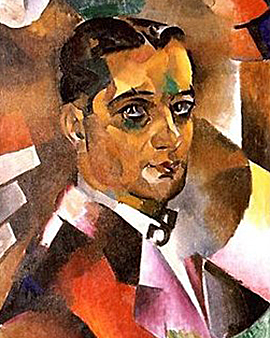Embedded in the vibrant culture of the 20th century, the life of Vladimir Davidovich Baranov-Rossiné tells an impressive story of artistic passion and technical innovation. Baranov-Rossiné, born on December 20, 1887 in Bolshaya Lipaticha in the Russian Empire, was a man of many talents - a master of painting and sculpture, a pioneer in the theory of color music and light-music kinetics. His contribution to the field of camouflage in military technology is remarkable. Each of his works in our art prints is a testament to his immense creativity and unwavering innovative spirit.
Baranov-Rossiné spent the early years of his career in the prestigious art schools of Odessa and Saint Petersburg. Despite his formal education, he was distinguished by an unconventional approach to art, marked by Futurist and Suprematist influences. His innovative nature found its way into his invention of the optophonic piano, a unique instrument that combined sound and color and projected them on a screen. This extraordinary creation is captured in our fine art prints, which represent not only his artwork, but also his technical genius.
After his return from Norway, where he had a remarkable exhibition in Oslo, Baranow-Rossiné deepened his interest in the combination of art and technology. His stay in the Parisian artists' colony La Ruche from 1910 to 1914 was another milestone in his career. Here he showed his works under the name Daniel Rossiné and expanded his artistic horizons. Despite the heavy losses in his personal life, including the death of his first wife during the birth of his first son, Baranov-Rossiné never let his artistic zeal die. After returning to Russia, he continued his work and even founded the Optophonics Academy after emigrating to France. But his flourishing career was interrupted by the outbreak of World War II. Because of his Jewish background, he was arrested by the Gestapo in 1943 and deported to the Auschwitz-Birkenau concentration camp, where he died in 1944.
The tragic end of his life underscores the importance of his work and the courage he demonstrated in the face of such adversity. Baranow-Rossiné leaves behind a legacy of creativity and innovation that is preserved to this day in our high-quality art prints.
×





.jpg)
.jpg)
.jpg)
.jpg)
.jpg)
.jpg)
.jpg)
.jpg)
.jpg)
.jpg)
.jpg)
.jpg)
.jpg)
.jpg)
_-_(MeisterDrucke-1428113).jpg)
_-_(MeisterDrucke-1428113).jpg)
.jpg)
.jpg)
.jpg)
.jpg)
.jpg)
.jpg)
.jpg)
.jpg)
_(oil_on_canvas)_-_(MeisterDrucke-1115957).jpg)
_(oil_on_canvas)_-_(MeisterDrucke-1115957).jpg)
.jpg)
.jpg)
.jpg)
.jpg)
_-_(MeisterDrucke-1209914).jpg)
_-_(MeisterDrucke-1209914).jpg)
_Oil_on_canvas_c_-_(MeisterDrucke-1030726).jpg)
_Oil_on_canvas_c_-_(MeisterDrucke-1030726).jpg)
.jpg)
.jpg)
_-_(MeisterDrucke-1427638).jpg)
_-_(MeisterDrucke-1427638).jpg)
_Peinture_de_Vladimir_Baranov-Ro_-_(MeisterDrucke-1318166).jpg)
_Peinture_de_Vladimir_Baranov-Ro_-_(MeisterDrucke-1318166).jpg)
.jpg)
.jpg)
.jpg)
.jpg)
.jpg)
.jpg)
.jpg)
.jpg)
_Peinture_de_Vladimir_David_-_(MeisterDrucke-1323054).jpg)
_Peinture_de_Vladimir_David_-_(MeisterDrucke-1323054).jpg)
.jpg)
.jpg)
.jpg)
.jpg)
.jpg)
.jpg)
.jpg)
.jpg)






